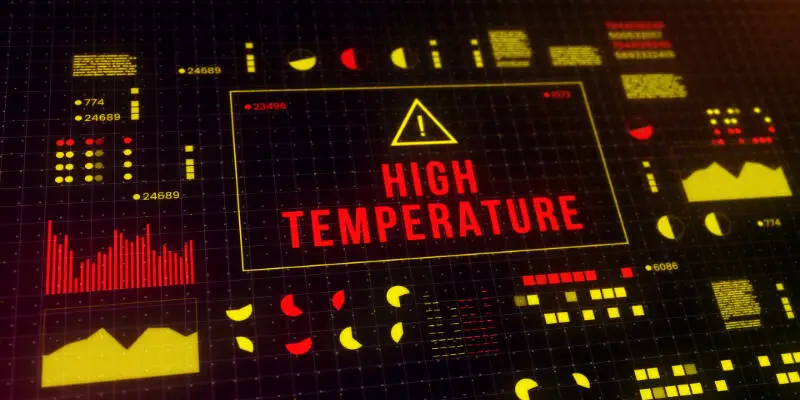Disclaimer: This post may contain affiliate links, meaning we get a small commission if you make a purchase through our links, at no cost to you. For more information, please visit our Disclaimer Page.
Monitors are one of the most important parts of the hardware for computers. They are the component which gives us the full experience while browsing the Internet or playing high-resolution games. Using computers would be impossible without them. They can endure similar problems as the rest of the hardware, but can they overheat?
Monitors can definitely overheat. When the temperature rises, the monitor shuts off to prevent possible damage of the circuitry inside. The reasons could be various.
Fixing computers can be a really tough job even if you’re a professional and especially if you’re just an amateur. It is stressful because it can take a lot of time just to identify the issue and repairs can be really expensive.
This article is for the people who may not know what is going on with their monitor and trying to fix it themselves. Sometimes a quick fix is just what you need.
Table of Contents
What Is a Symptom of an Overheating Monitor?
It’s very stressful when your monitor overheats, especially if it is the first time it has done that. A million complications come across your mind and you’re hoping for the best but really, expecting the worst.
The first thing you should do is calm yourself because panic won’t help you in any way, shape or form. Then you should make sure you are safe.
Unplugging the monitor from power is the first action you should take to make sure that you and the environment around the computer station is out of harm’s way. This action eliminates possibilities of damage to the circuity inside.
After unplugging the monitor you should let it cool off before trying to turn it on again. Canned air would be very useful at this point. You should blow the canned air inside of the monitor casing to get rid of any dust.
In case the whole computer room is hot, turn on the air conditioning to cool it down.
Here’s a breakdown of the monitor overheating symptoms:
- It’s too hot to touch!
The most obvious symptom of an overheating is a high temperature of the monitor. In that case you must follow all the advice from above to keep yourself and your hardware and software intact.
- Lines of pixels appearing on the screen.
This can be either a problem with the monitor, or a problem with your graphics card. You should check if the graphics card is overworked and if it has enough ventilation to reaching it.
- Monitor which keeps turning off for no reason.
You’re playing a game and the monitor suddenly crashes down? This is a common symptom of a monitor overheating. After it crashes, check its temperature, and if it’s high, leave it alone to cool down.
Even if you experience only one of these signs of an overheating monitor, check for the other listed above. The most important thing is to let the computer cool down and not overwork it.
How Do I Cool Down My Monitor?
Now that you diagnosed your computer with overheating, it’s time to cool it down. There are a few things you can do, so let’s get into it:
You should turn off your computer and monitor.
This will eliminate the chances of damage to the hardware.
Change the VGA cable.
That’s a cable that connects the monitor with the computer’s video card. A bad cable can cause different issues, but overheating is the most common one.
Clean the vents with canned air.
You open a case of your monitor and spray from the can. You must hold it straight and not tilt it because the liquid can come out which can damage the components. You can get it at any computer or electronics store. Be careful not to get too close with the can. It should be 10-15 inches away from the vents.
Use the PC vacuum
PC vacuum is a specially designed vacuum for cleaning the PC’s hardware. You can get it on places like Amazon or computer stores.
Attach the nozzle part to the vacuum and place it over the vents to get rid of dust and debris. Be sure to specifically use PC vacuums and not the regular ones because they will cause static build-up in your monitors while the PC ones won’t.
Adjust your power options
You should go to Settings and adjust the screen to turn off while it’s not being used. When the screen does that, it will have time to cool off before you start to use it again.
If you try all of this and nothing helps, you should call a computer repair technician. They definitely know more than you do.
What Are the Causes of a Monitor Overheating?
Computers produce a lot of heat. They use fans or alternating cooling systems to keep the computer running smoothly.
Most of the heat is produced by the graphics processor and the CPU, but the hard drive motor can also contributes to the rise of the temperature. The more difficult tasks you give the computer to run, the more it produces heat.
Now that you made sure that the monitor is cool and your hardware is safe, it’s time to try and find the causes of the overheating and solve the problem from the root.
First thing first, you need to make sure if it’s just a monitor problem or something else. Here are two tips:
- If the power light on the monitor turns from green to orange, that means you only lost signal and the problem is the computer itself.
- If the computer keeps turning off when you’re not using it, but it turns on when you press any button, it’s also not the monitor’s fault. Those are just power management settings you can change anytime.
Now when you got that out the way, it’s time to identify the real issue. Overheating can be explained by various causes:
Dust build-up
This is a very common cause of overheating hardware because dust gets in everywhere and it’s hard to notice it. Many people don’t even know that dust gets inside computer parts and stops it from working properly.
The dust concentration is even higher when you keep your laptops on your bed and the comforters. You should always keep it on a desk or on some cool material.
The interesting thing a lot of computer users don’t know is that cigarette ash also gets in your laptop and can ruin the performance of it.
The best thing you can do is get yourself canned air for electronics. It is the best for removing dust and dirt from the inside of the computer. It looks exactly like a hair spray and it’s easy to use.
Blockage of the vents
Just as the computer case has vents, so does the monitor. They are usually located on the side of the case and they are very narrow. You should lightly blow the canned air around them to clean them and proceede to clean the inside.
Make sure there is enough space around the vents and that nothing’s blocking them.
Excessive heat
Excessive heat or humidity can also overheat the laptop, giving it no chance to cool down. This isn’t a common problem and these are extreme situations.
The water from the air can slowly damage the components and destroy the computer.
Is It Okay to Leave Your Computer on All Night?
There are a lot of reasons you leave your computer on at night. First, it’s convenient. You can get back to your work right away.
Doing backups and installing different programs is more easier overnight because it takes some time and it leaves the computer doing just that so it gets done faster. It doesn’t interfere with any other work.
Some arguments against it are that it can damage the hardware because of the heat and it uses a lot of electricity. Those are valid arguments, but are they true?
It depends on how much you use your computer daily and what kind of work does the computer do.
Times have changed regarding the computer’s usage of electricity. When the computers were made with tube-style monitors, they used a lot of electricity on daily basis.
Today, the computers’ components are made in a way that they can individually go to sleep. What does that mean?
It means that when they go to sleep mode, they reduce the produced heat and it actually extends the life of different components.
Laptop computers are even more efficient. They consume a fraction of the power which a desktop computer does, so you can probably leave it all night without worrying about heat and the usage of electricity.
If you really want to take all the precautions, you should change the screen saver’s option to change different backgrounds. It uses a lot of power and it’s unnecessary.
If you keep your computer on 24/7, you should consider rebooting. Rebooting closes all the programs and tasks. It is usually done when there’s a problem with operating the computer both on Windows and Mac. It is important to reboot the computer once a week at least.
Sleep Mode or Hibernation?
Sleep mode puts the computer in low-power usage. It keeps everything where you left it but keeps the RAM active.
You can also hibernate your computer. The difference between hibernation and sleep is that hibernation doesn’t store everything on RAM. It creates a file on the hard drive where it stores everything and shuts down the system. What is better?
Hibernation uses no power. The computer is shut down, but it takes longer to restart it. It is the best for a laptop which runs on a battery.
You should always take care of your computer’s hardware. You need to remove the dust and dirt from components regularly and remove any obstacles that can block the air passage from vents.
Don’t overwork the computer when it starts to overheat because you will only damage it that way. Remember, the more you take care of it, the longer it will last.


